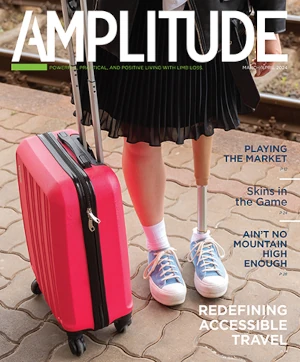
Ortiz Catalan (left) and Brånemark (right) with the first patient treated with the osseointegrated implant system for neural control. Photographs courtesy of Max Ortiz-Catalan et al., Science Translational Medicine, 2014.
In January 2013, a gentleman from Sweden who had undergone a transhumeral amputation more than ten years prior, was the first person in the world to receive a prosthesis with a direct connection to bone, nerves, and muscles. An article about this achievement and its long-term stability was published October 8 in the Science Translational Medicine journal. Click here to see the arm in action.
“Going beyond the lab to allow the patient to face real-world challenges is the main contribution of this work,” said Max Ortiz Catalan, PhD, a research scientist at Chalmers University of Technology, Gothenburg, Sweden, and leading author of the publication. “We have used osseointegration to create a long-term stable fusion between man and machine, where we have integrated them at different levels. The artificial arm is directly attached to the skeleton, thus providing mechanical stability. Then the human’s biological control system, that is nerves and muscles, is also interfaced to the machine’s control system via neuromuscular electrodes….”
The direct skeletal attachment is created by osseointegration, pioneered by Associate Professor Rickard Brånemark, MD, MSC, PhD, and his colleagues at Sahlgrenska University Hospital, Gothenburg. Brånemark led the surgical implantation and collaborated closely on the project with Ortiz Catalan and Bo Håkansson, PhD, a professor and leader of the biomedical signals and systems research group at Chalmers.
The patient’s prior prosthesis was controlled via electrodes placed over the skin. Now, the patient has been given a control system that is directly connected to his own. He is employed as a truck driver in northern Sweden, and since the surgery he has experienced that with the prosthesis he can handle daily activities, from clamping his trailer load and operating machinery, to unpacking eggs and tying his children’s skates, regardless of the environmental conditions.
“We demonstrate…that implanted electrodes provide a more precise and reliable control than surface electrodes, regardless of limb position and environmental conditions, and with less effort,” the study states.

The osseointegrated prosthesis shows robust neural control in activities of daily living and regardless of limb position. It is also resistant to electromagnetic interference.
The patient is also one of the first in the world to take part in an effort to achieve long-term sensation via the prosthesis. Because the implant is a bidirectional interface, it can also be used to send signals in the opposite direction-from the prosthetic arm to the brain. This is the researchers’ next step: to clinically implement their findings on sensory feedback.
“Reliable communication between the prosthesis and the body has been the missing link for the clinical implementation of neural control and sensory feedback, and this is now in place,” said Ortiz Catalan. “So far we have shown that the patient has a long-term stable ability to perceive touch in different locations in the missing hand. Intuitive sensory feedback and control are crucial for interacting with the environment, for example to reliably hold an object despite disturbances or uncertainty….” The researchers plan to treat more patients with this novel technology later this year.
“We see this technology as an important step towards more natural control of artificial limbs,” said Ortiz Catalan. “It is the missing link for allowing sophisticated neural interfaces to control sophisticated prostheses. So far, this has only been possible in short experiments within controlled environments.”



